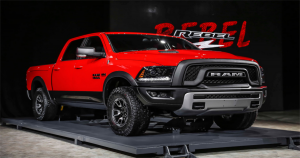By: Thomas Wigand | New Zeal
Mr. Wigand is the author of the book Communiqués From the Vast Right-Wing Conspiracy (available on Amazon in both print and Kindle versions). Comments or questions for Mr. Wigand may be sent to: [email protected].

READ ON; YOU’LL HAVE SOME LAUGHS BEFORE WE’RE THROUGH!
Before occupying the Presidency, Comrade Barack Obama was a “community organizer” – an amorphous term that came out of the Leftist alley into the main street lexicon during the 2008 campaign cycle. Few knew what it meant, and most did not examine it.
Indeed, the collusive, “mainstream” media glossed-over the radical origins and implications of “community organizing.”
However, others did examine it – after all, what the heck is a “community organizer” anyway? And why would someone graduating from Harvard Law School go on to become a “community organizer?”
The trail led to decades-old book well known to the Left, but relatively unknown outside of it: Saul Alinsky’s “Rules for Radicals.”
Alinsky invented the “occupation” of “community organizer,” and his tactics inspired a generation of Progressive revolutionaries, who by the early 1970s
Alinsky, in turn, appeared to be inspired by the likes of Antonio Gramsci and what came to be known as the “Frankfurt School.” Those revolutionaries proposed that the path to (Communist) revolution in the advanced, western nations was not through open revolution, but a “long march through the institutions.”
True revolutionaries do not flaunt their radicalism. They cut their hair, put on suits and infiltrate the system from within. – Saul Alinsky
In other words, by burrowing inside government, media, religious institutions and academia, and slowly displacing the existing culture with a more, well, “progressive” one. To undermine us from within, using stealth and subterfuge and gradualism, so that Americans would not recognize the threat – until it was too late.
Tactics such as running for Illinois Senate, then U.S. Senate, and then President of the very country you intend to “fundamentally transform” into a Collectivist state.
At the time “Rules for Radicals” was published, its intended audience of revolutionaries, err, “community organizers,” was considered the “counter-culture” – the folks without power, fighting those in power. Alinsky’s “Rules” were (and still are) intended to outline practical tactics for becoming the ones holding the power.
They have the guns and therefore we are for peace and for reformation through the ballot. When we have the guns then it will be through the bullet. – Saul Alinsky
Alinsky’s tactics work: Who today controls the media and academia? Who, through the Democrat Party and bureaucracy, mostly controls the government? Who is ever more influential within religious institutions (and have completely flipped some, e.g., Episcopalians)?
Why, that would be today’s embodiment of Alinsky, the Progressives.
We, the “Deplorables,” are now the counter-culture!
We are the ones without power; the ones who need to seize it in order to save our Republic from Collectivism.
Now that we find ourselves in this position, doesn’t it make sense to use their (successful) tactics back at them, so we can begin our own “long march back through our institutions?” In this piece we will focus on two of Alinsky’s Rules: “Ridicule is man’s most potent weapon” and “A good tactic is one your people enjoy.”
With that in mind, let’s consider recent advertising campaigns. Many of us have noticed the ever-increasing amount of “social justice warrior” messaging and imagery embedded within commercials (including the seemingly obligatory depiction of men – at least White men – as clueless). Gillette’s recent (and now infamous) “toxic masculinity” ad campaign titled “We Believe” was a predictable escalation of this dynamic.
What if we the Deplorables began to fight back; tangibly beginning that “long march back through our institutions?”
For example, what if a company and its advertising agency had the cajones to turn current advertising shibboleths on their head, and launched an Alinsky-inspired counter-cultural campaign ridiculing the “social justice warrior” mantras du jour?
What might such an advertising campaign look like? Glad you asked!
Let’s start with pickup trucks, the advertising for which has been one of the last redoubts for positive imagery of traditional (genuine) masculinity. For this hypothetical, what if Dodge Ram launched a campaign ridiculing the whole “toxic masculinity” shtick in particular, and the whole “social justice warrior” agenda overall? An ad campaign actually designed to trigger Progressives and their delicate sensibilities?

Well, how about scripts like these? (Read a concept, then close your eyes, and in your mind’s eye try to imagine how it would look if you were watching on TV):
Ad Concept # 1 (“Waxing Your Chest Instead of Your Trucks”)
A close-up shot shows the rear end of a Toyota Prius coming into focus as it parks. The rear end is plastered with “leftie” stickers (as we see so often on such vehicles).
The camera pans back and next to the Prius are RAM trucks, and some burly looking guys – ranch hand / construction looking guys as one usually sees in truck ads – standing on the sidewalk in front of some stores, chatting.
Out of the Prius jumps a metrosexual – skinny jeans – “man bun” sort of character. The camera swings around to follow as he prances into a shop with a sign above the door: “Unisex Waxing.”
The camera pans back to the burly guys, who don’t say anything but smirk and chuckle derisively as the voiceover announces: “RAM. The truck for guys who like having hair on their chests.”
Alternative voiceover: “RAM. The vehicle for guys who wax their trucks, not their chests.”
Fade out.
Ad Concept #2 (“The Truck for Stand-Up Guys”)
A RAM pulls up to a gas station or store, in front of the restroom door(s). A burly guy gets out and goes up to the door, only to spy one of those “all genders” signs. He cautiously opens the door and sees that there are only stalls, no urinals. He grunts disapprovingly. Looking around to see if anybody’s watching, and then furtively walks around the corner to stand facing an abutting wall.
Screen goes black momentarily to denote a passage of time. Next, we see him coming back (urine stained wall behind him), zipping his paints as he is approaching his truck. Voiceover as this is happening: “RAM. The truck for stand-up guys.”
Fade out.
Ad Concept #3 (“RAM It Home”)
A burly guy (construction worker or similar) gets off work, obviously after a hard day of honest labor, and begins driving home in his RAM. He pulls into his driveway, and we see his wife standing in the doorway with a “come hither” look on her face. Voiceover as this is happening: “Hard working guys earn the right to RAM it home” (showing the truck in the background for the double-entendre).
Alternative voiceover: “After a hard day’s work, there’s nothing better than RAM-ing it home.”
Fade out.
Ad Concept #4 (“Safe Spaces”)
A burly guy in the cab of his RAM, driving down the road. The radio is on, and we hear a newscaster saying: “Today at the university, students demonstrated, demanding that the university provide ‘safe spaces.’”
We see the driver (derisively smirk) as he reaches down to change the channel. The beginning of the Pretenders song “My City Was Gone” can be heard – a signal to the cognoscenti that he has switched to listen to Rush Limbaugh.
The camera angle then changes, looking through the windshield from the front of the RAM, panning back into wider angle from the drivers face. As it continues to pan back (or zoom out if you prefer), more of the cab’s interior comes into view, until one can see a lever-action rifle in a rack behind the driver’s head.
As this occurs, the voiceover comes in: “RAM. The truck for guys who make their own ‘safe spaces.’”
Fade out.
Ad Concept #5 (“Hauling Ass”)
The scene begins with a donkey facing into the wind, so hard that its ears are blowing back. As the camera pans back, we see that it is being hauled behind a RAM.
Camera angle shifts to the side of the truck, looking at the burly driver through the open driver’s window.
After a moment he turns to face the camera, with a grin on his face. Immediately after the voiceover comes in: “RAM with Hemi power. The truck for guys who like to haul ass.” Just as the voiceover finishes the burly guy winks, and then the truck quickly accelerates.
Fade out.
Ad Concept #6 (“Big Balls”)
Multiple scenes appear depicting RAM’s (driven by burly guys) hauling large, globe-shaped objects such as mooring buoys, fuel tanks and such. After a bit the voiceover chimes in: “RAM. The truck for guys with big balls.”
Alternative voiceover: “RAM. The truck for guys doing jobs that require big balls.”
Fade out.

Commercials such as the above would inevitably produce condemnation and all the usual social justice huffing and puffing.
Oh yeah, they’d be triggered – and how!
Yet at the same time, purchasing and driving a RAM could well become a form of “virtue signaling” by men tired of being demonized by Progressives (and Madison Avenue); a way of declaring that they’re a real man who won’t be browbeaten into embracing all of that “toxic masculinity” crap.
Yes, driving a RAM truck could come to symbolize something akin to operating a rolling “MAGA hat.” A mobile middle-finger to the peddlers of “toxic masculinity” and the rest of the “social justice warrior” agenda.
Which would leave just one question about buying a RAM: Where do I sign?
Mr. Wigand is the author of the book Communiqués From the Vast Right-Wing Conspiracy (available on Amazon in both print and Kindle versions). Comments or questions for Mr. Wigand may be sent


















